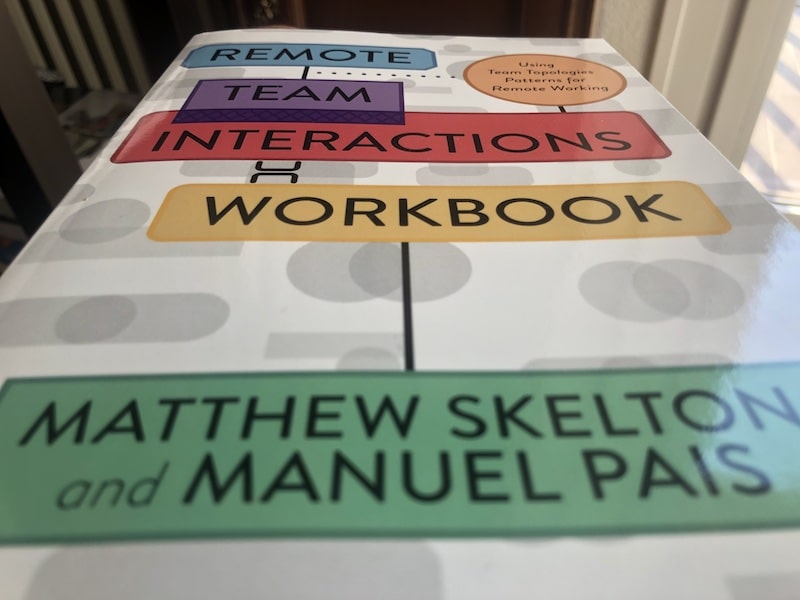Book notes: Remote Team Interactions Workbook: Using Team Topologies Patterns for Remote Working
Book notes on "Remote Team Interactions Workbook" by Matthew Skelton and Manuel Pais

These are my notes on Matthew Skelton and Manuel Pais’s Remote Team Interactions Workbook: Using Team Topologies Patterns for Remote Working .
A Team Topologies companion with homework to map your current team topologies, and useful advise for remote work.
Thanks to ITRevolution for the complimentary copy!
Key Insights
- Physical office was covering up poorly defined teams and poorly defined ares of focus.
- In a remote work setting, it is vital to “over communicate”.
- In remote settings, keep it shorter and sharper: it’s harder to hold people’s attention remotely.
- Facilitating interaction longer than a few weeks suggests something isn’t quite right.
- In the context of remote work, it is too easy to accidentally fall into a swamp of direct private messages.
Homework
- Define your Team API.
- Track team dependencies.
- Start a network-building event: communities of practice, internal tech events, lunchtime talks, coffee breaks.
- Trust boundaries assessment.
- Online space assessment.
- Cognitive load assessment/Internal platform survey.
Preface
- Physical office was covering up poorly defined teams and poorly defined ares of focus.
- A successful remote-first approach requires the explicit design of communication between teams using physical and online spaces.
Chapter 1 - Overview - Focus on Remote Team Interactions
- Google’s five keys to successful teams:
- Psychological safety.
- Dependability.
- Structure and clarity.
- Meaning.
- Impact.
- Cognitive load assessment:
- This is something the platform team should use as a KPI.
- Problematic dependency between teams, symptoms:
- Delays.
- Increase WIP.
- Unpredictability.
- Instead of waiting, focus on tracking and then removing the in-flow dependencies.
- Making Work Visible by Dominca De Grandis.
- In a remote work setting, it is vital to “over communicate”:
- What, why, how, when will be done.
Chapter 2: Team Dependencies
- Techniques to track and manage inter-team dependencies, to promote healthy ones, and minimize others.
- Team API:
- For remote teams, especially important:
- Road map: how to notify changes?
- Communication preferences:
- Channel, schedule.
- Expected response time.
- Template
- For remote teams, especially important:
- Dependencies can never be fully eradicated.
- Not all dependencies are the same:
- Blocking vs non-blocking.
- Healthy vs unhealthy.
- Frequent vs infrequent.
- Tracking dependencies:
- Add dependency tag to stories.
- Physical dependency matrix.
- Dependency swimlane board:
- Add a specific lane to your Kanban board with the tasks that depend on other teams.
- Simple table.
- Internal network:
- Virtual coffee.
- Internal conference.
- Communities of Practice.
- Brown bag sessions.
- Enabling teams.
- Keep it shorter and sharper: it’s harder to hold people’s attention remotely.
Chapter 3: Setting Team Boundaries
- Group trust boundaries:
- Dunbar numbers.
- Groups slightly smaller than the trust boundary are likely to have good trust. Larger than are likely to have trust issues and are candidate to splitting into smaller groups.
- When the size of an online space reaches a trust boundary, create a new space.
- Online space aligned to flow of change.
- Optimize for trust within online spaces.
- Chat tools:
- Standardise channel names:
- TeamType_TeamName.
- Team_InteractionMode_Team.
- People name to include team they belong to.
- Explicit etiquette.
- Standardise channel names:
Chapter 4: Purposeful Interactions
- Facilitating interaction longer than a few weeks suggests something isn’t quite right.
- Difficulties or awkwardness in team interactions can be used as a kind of sensing mechanism to help evolve the org.
- Focus on flow.
- In the context of remote work, it is too easy to accidentally fall into a swamp of direct private messages.
- Define usage guidelines for Slack/Teams/…
- Curate the chat workspace.
Chapter 5: Next steps
- Internal Platform survey.
- Internal personas.
- Naming and usage for chat tools: don’t attempt to design everything upfront, allow some patterns to emerge.
- Expect rework.